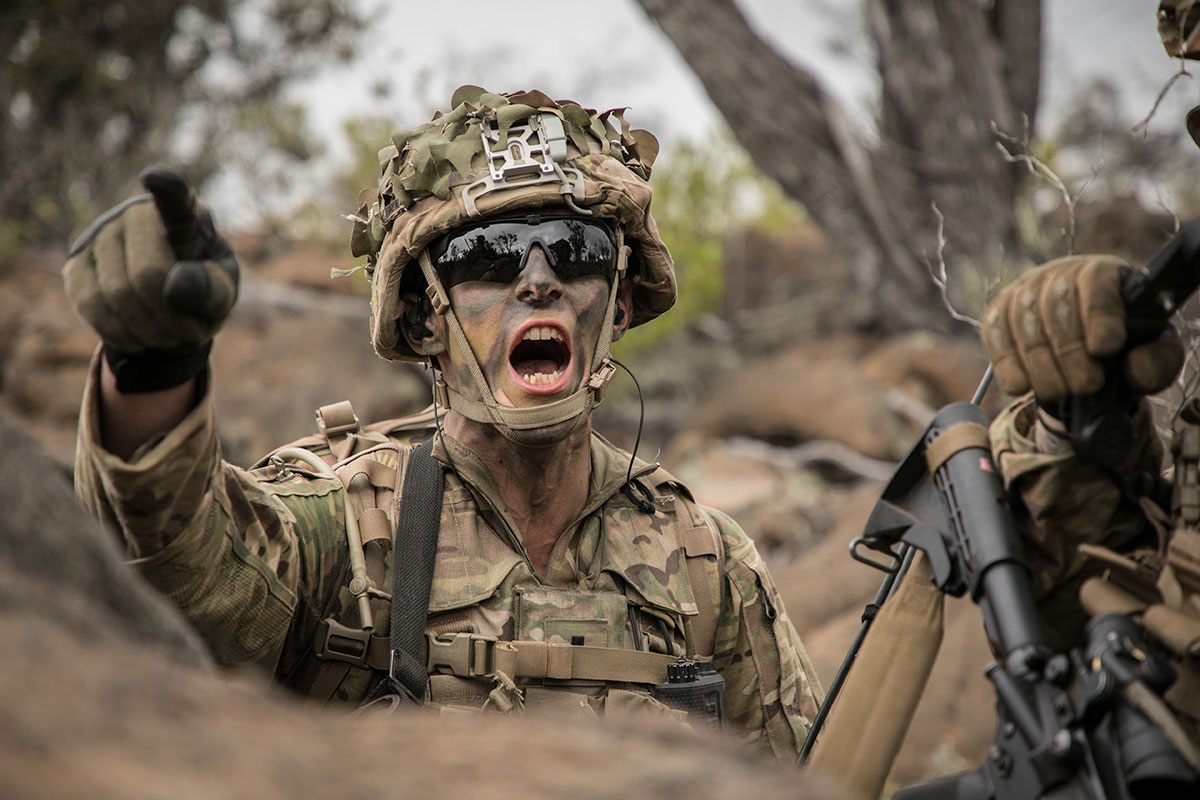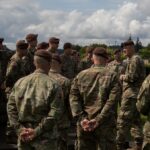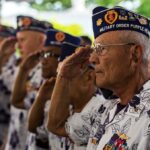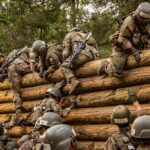
In the face of so much change in the private sector, continued adherence to formal structures in the military seems old-fashioned.
Without a doubt, the chain of command is one of the most durable concepts in military organizations. From Roman times until present, the chain of command fixed formal authorities and accountability from the highest leader to the front line soldier. It made the generation, issuing, and following of orders simple despite the vastness of formations being put to battle. The chain also formalized the separation of officers and soldiers into different castes. As societies industrialized, formal chains of command were instituted in bureaucracy which would become the leading model of organization in the civilian sector.
But times are changing, and the civilian sector has been moving away from traditional bureaucracies because they can be too rigid in the face of information age challenges. From “flattening” organizations in the late 20th century to today’s algorithmic management, modern control and coordination structures are flexible and more responsive. From Google to Uber, dynamic organizational structures have proven very successful in meeting customer needs.
What about the military? With so much change in the private sector, continued adherence to formal structures in the military seems old-fashioned. On current and future battlefields, Strategic Corporals exercise leadership; cyber warfare, artificial intelligence, and robotics are standard features; urban environments are the probable settings; and war will be cross-domain, high-speed, and complex. The military has already evolved much of its norms and practices away from the linear chain into greater reliance on centers and working groups, vestiges of flatter structures. But how far should this go? Is the linear chain truly no longer relevant? These are the subjects of this essay.
Questions of Power
A criticism of the linear chain is the degree to which it favors positional power, which combines legitimate (based on vested authorities), coercive (based on fear and sanction), and referent (based on something drawn from the organization, such as one’s rank) power. The reliance on positional power is straightforward. Soldiers needed orders from powerful commanders capable of convincing soldiers to advance in battle. Other benefits include timeliness of decisions and clearly fixed responsibilities – such as the operating assumption that commanders are responsible for all that happens within their units. Also, many specialists rely on referent power, such as military police who, despite typically lower rank, command great authority by virtue of their specialized roles in the military judicial system.
As an organizing construct, linear chains can be costly. One cost is the introduction of single points of failure, where a communication breakdown can bring along a domino effect as a mistake propagates across a large formation. Another is the risk of coercive power becoming dominant, in which leaders show lessened respect or consideration of the views of subordinates. The result is a poor command climate. But not all costs are associated with human error. An important cultural artifact of positional power – that of the officer-enlisted divide – deserves renewed scrutiny.
Three distinct classes exist in the U.S. armed forces: officer, enlisted, and warrant officer (although the Air Force no longer has warrant officers). The formal chain of command reinforces the distinction by setting qualitatively different entry-level requirements, such as education and conferring greater social status to officers as was done in the British system. This has been criticized as promoting an “aristocracy” that has no place in modern militaries, as well as the cultural divide that separates officers from enlisted persists.
In practice, military organizations routinely work around this artificial divide. Within each class hierarchy, the military has unspoken rules or conventions that define and often erase the distinctions of pay grade. When a soldier becomes a First Sergeant, Sergeant Major, or Command Sergeant Major, he or she often takes on the authority (the echelon) of the Commanding Officer and thus has commensurate authority, beyond the pay grade. In many headquarters, commanders assign high social status to their senior enlisted leaders such that they sit well above where ordinary protocol would place them (fondly called “echelons above”).
The linear chain had its day when unity of command across a wide front necessitated a clear, unambiguous line of communication from top to bottom.
In the twenty-first century, modern tools, technologies, and ways of organizing and interconnecting have brought new challenges to the ideas of a strictly vertical chain of command. After watching a World War II movie, the first author’s young daughter asked, “Who is in charge? The Sergeants or the Generals?” This simple question had no easy answer even in World War II, but the military culture has clung to the fiction of supreme power vested at the top. Leaders lead; followers follow. Go to any headquarters and one can find on display the chain of command in a series of official photographs starting with the President and down the line to the local commander, with the NCO chain of support often depicted nearby. In reality, the power equation is evolving and situational.
Shared Leadership
Civilian organizations have found constructs of shared leadership attractive. For example, instead of one CEO, why not two or more co-CEOs? In complex organizations, it may be best to bring together two or more people with complementary skill sets to run the organization, rather than rely on a single individual. A number of major businesses are following this trend.
Or what about a “CEO of the month”? Consider the following analogy. Canada Geese usually fly in a wing formation with the lead goose taking the point position while the other members of the flock honk encouragement. After bucking head winds for a time, the lead goose fades back into the formation and another goose takes the lead. This idea of rotating leadership goes back to the ancient Romans who recognized the stress that being in leadership positions can have on individuals.
The idea of shared leadership has been around a long time, but its recent increase in popularity may be because of the greater resiliency, flexibility, and responsiveness required in today’s dynamic competitive environments. However, when decisions need to be vetted by the full team of leaders, shared leadership actually adds to the leadership burden. Therefore, shared leadership is more likely to succeed when the organizing construct leverages personal power that combines expert (based on knowledge), information (based on situational awareness and observation), and charismatic (based on capacity to influence) forms of power. Personal power has always been very important for finding workarounds, negotiating solutions to complex problems, and pursuing change. Those who wield it, like Sergeant York and Major Oliver North make big differences.
How Would it Work?
Famed management scholar Chester Barnard showed that the authority expressed in a military organization exists only if accepted and enacted by the service members, especially non-commissioned officers. In this way, introducing constructs of shared leadership can work when it is understood and expected by the troops. No physical or structural barrier precludes moving to a shared leadership construct; rather barriers are cultural. Some organizations already embrace forms of shared leadership, such as in combat support organizations where senior military officer directors are paired with a civilian deputy who confers continuity and special expertise. Or, the civilian may lead as Director and the military officer is the deputy to ensure the organization remains sufficiently tied to the military mission. In such cases, clear terms of reference divide responsibilities. Similarly, other organizations would need to draft terms of reference to ensure clarity of authorities and responsibilities in the minds of the organization’s members.
Rotating leadership is presently done in training environments where cadets or trainees take turns leading to gain experience and confidence. Can this carry over to others environments, such as peacetime, where rotating leadership can build the needed confidence for independent distributed action in a future battlefield? The benefits would be many – organizations would be more resilient against the loss of leaders in combat.
The linear chain had its day when unity of command across a wide front necessitated a clear, unambiguous line of communication from top to bottom. The movement to Mission Command was a first step in a new direction; scrutinizing the stranglehold we have on the chain of command as primary organizing construct is the logical next step. Like the Canada Geese, leaders need to know when to lead, when to follow, and when to honk encouragement. The restrictive channels we currently rely on make it difficult for leaders to do just that. If the U.S. military is to excel in complex, dynamic environments, it has to be willing to call into question everything it takes for granted – even if it something so entrenched in military culture as the chain of command.
Michael Piellusch is an Adjunct Professor at Argosy University. Tom Galvin is Assistant Professor of Leadership Studies at the U.S. Army War College. The views expressed in this article are those of the authors and do not necessarily reflect those of the U.S. Army War College, U.S. Army, or Department of Defense.
Photo: A Soldier assigned to 25th Infantry Division signals his platoon during a Combined Arms Live Fire Exercise at Pohakuloa Training Area, Hawaii, May 15, 2018.
Photo Credit: U.S. Army photo by 1st Lt. Ryan DeBooy





Interesting discussion, but it appears, though, that there is a missing component – in a “non-linear” command structure where does accountability and responsibility for outcomes lie?
If someone has the apparent authority to order actions that could lead to the death of those tasked with executing the ordered action, but is not accountable for the actions ordered, can an organization ultimately dependent on a very high level of trust between the leaders and the led, such as a rifle company in combat, be sustained?
Trust is the glue that holds our formations together under the greatest stress possible. How can trust be built and sustained absent a clear and coherent command structure in which the led know that their leaders will be there at the end of the operation as well as at the beginning, ie that the leaders will be held accountable for their decisions?
Very thought provoking and concur with above comment regarding accountability. Linearity works well for “active threats” when time is an element and immediate reaction is required. More collaborative process are more appropriate when immediacy is not an issue. Emergency management realized that typical hierarchical stovepipes do not work for complex problems and developed an ad-hoc system that ensures those on the ground are in charge (rather than leaders that are miles away).
Instead of changing hierarchical structure – perhaps we need to recruit and educate leaders in application? Leaders need to realize they are not the “smartest in the room” and all knowledge does not reside in them. They need to recognize the talent and expertise of those that work for them and leverage it. In other words, just because they are in a linear organization, does not mean they need to be linear thinkers. We do have many that can do that – unfortunately, as others have noted, what makes one a successful tactician, does not necessarily transfer to strategic leadership. Good leaders rise above less-than-ideal organizational structures, are flexible and, are able to institute appropriate collaborative processes.
EXCELLENT POINT!
But, alas, reality is often
different.
Civilian institutions still need accountability and structure for decision-making. All the talk about flattening organizations might be better described as placing decision-making authority where it best lies, appropriate for the nature of the decision being taken, and simplifying or (de-bureaurcratizing) organizational structures. It does not mean removing the chain of command. In practice, a lot of the flattening and de-centralizing talk in civilian organizations is just talk, and it can frustrate employees who don’t know to whom to turn if there are issues or uncertainties. It can actually decrease accountability and lead to decision-making by default, neither of which is desirable.
In addition, one should be careful about simply adopting civilian systems to the military: the former don’t have to deal with conditions of uncertainty due to the senior leadership being suddenly killed.
The system is very good at holding platform and unit commanders responsible for the safe and effective operation of their commands. It is much less effective at holding network commanders responsible for anything. Unfortunately any operational level organization is by its very nature a network. So are the computer, communications, surveillance, intelligence,and reconnaissance supporting media that are huge in scope and will be continually contested across the spectrum of warfare. These networks shape th operating environment to the point that tactical success can be decisively impacted. Remember that mission command , command by negation,and commander’s intent are meaningless if the operational commands cannot see and review the the tactical situation in the AOR and AOI in real time – a process totally dependent on networks!!
Esteemed colleagues,
Thank you for the commentary! The identified topic of accountability may well be the Achilles heel of the concept of “shared leadership”; however, one might postulate that accountability can be shared and at times rotated without losing “the bubble” as conning officers say on the bridge of military and merchant ships.
During “special sea detail,” the military captain is usually on the bridge (unlike during the Exxon Valdez tragedy). The captain sometimes announces “I have the conn” after a brief status report “transferring the bubble” so to speak, or the captain might choose to observe the operational picture and assume the conn “in extremis” or “at will” as his or her mood or circumstances determine. The underway captain unequivocally is at the top of the shipboard chain of command.
During the Exxon Valdez disaster, according to David Lebedoff’s well researched book entitled Cleaning Up: The Story Behind the Biggest Legal Bonanza of All Time, Captain Joe Hazelwood had his ship transiting the Inbound traffic lane in order to avoid ice in the Outbound lane (with Coast Guard concurrence). With inexperienced Third Mate Gregory Collins with the conn, Hazelwood instructed the helmsman (Henry Claar) to put the ship on autopilot and “make a right turn when the tanker reached a certain point near Busby Island).” A few minutes later the watch rotated and helmsman Robert Kagan relieved Claar. Conning officer Cousins was apparently a little unsure of the “time to turn” so he was back on the chart table “checking the maps.” Lookout Maureen Jones was the first crew member to notice that the Valdez had missed the turn. The rest of the story is well known tragic history, but what are some of the lessons learned or lessons that could still be learned?
Captain Hazelwood had the command and the accountability, but he did not share his leadership effectively. He could have stayed on the bridge at least until the critical turn back into the Outbound lane was made. If he turned over the conn to his more experienced Second Mate, he probably could have avoided the tragedy as well. In other words, by leaving the bridge of his ship during a critical navigation challenge, Hazelwood did not share his leadership or his accountability effectively.
According to the Matrix Management Institute, accountability has traditionally been a one-dimensional concept in most organizations. In the 21st century, accountability and leadership are often shared in a two-dimensional or multi-dimensional environment. A shipboard disaster can serve as a thought-provoking case study, but many military engagements are much more complex than the movement of a single ship. Many wartime operations involve more moving parts and more opportunities to share and handoff “numerous bubbles” without losing the overall engagement.
I was a prior Enlisted man MOS 13 F in 3/75th RGR Regiment on Active Duty. I deployed wit the 81st BDE WA Army National Guard in 2004-5 with 1-161 IN Bn 81st and was a Squad Automatic Gunner on a 998 soft skin vehicle in Baghdad. I went to OCS and then I volunteered to deploy with the 86th BDE out of Vermont to RC East Afghanistan as a Fire Support Officer. Our Company XO was paralyzed by fear when we were attacked at FOB Rushmore. My CO & 1SG offered me his job and sent him to FOB Sharana. My CO had to leave theater and I was given my Assumption of Command orders. I had that form framed in UV light protective glass! When I try to explain this to people, I often get the cough (BS). I had to explain the scenario to an BG and a MG. I googled if there was anyone else who has done this and found no modern (post-WWII) examples. I must have happened in Vietnam, but I can’t find an example or AR that allows for it. I have written a few novels and have now been ask to go on a publicity tour by my publicist. It is going to come up and I want to cite an example of it rather than carry my framed copy around with me. Do you have any suggestions/ v/r Phillip D. Holt USA, CPT (ret)